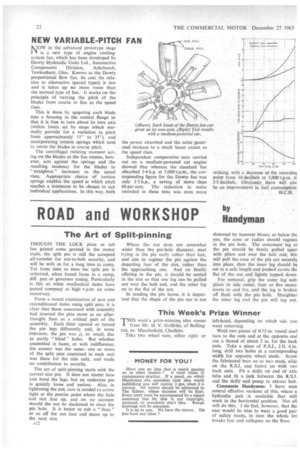ROAD and WORKSHOP ;I Y andyman
Page 24

If you've noticed an error in this article please click here to report it so we can fix it.
The Art of Split-pinning
THOUGH THE LOCK plate or tab has gained some ground in the motor trade, the split pin is still the accepted all-rounder for nut-to-bolt security, and will be with us for a long time to come. Yet from time to time the split pin is criticized, when found loose in a sump, diff. pan or governor casing. Particularly is this so when mechanical items have parted company at high r.p.m. on some motorway. From a recent examination of new and reconditioned items using split pins, it is clear that those concerned with assembly had inserted the pins more as an afterthought than as a critical part of the assembly. Each fitter opened or turned the pin legs differently and, in some
instances, the pin was in. small, due to partly " blind " holes. But whether assembled in haste, or with indifference, the answer was the same: one or more of the split pins examined in each unit was there for the ride only, and made no contribution to security.
The art of split-pinning starts with the correct size pin. It does not matter how you bend the Iegs, but an undersize pin is quickly loose and useless. Also, in tightening the nut, care is needed to arrive tight at the precise point where the hole and slot line up, and on no account should the nut be slackened to clear the pin hole. It is better to rub a " thou " or so off the nut face and move up to the next slot.
A2
Where the nut slots are somewhat wider than the pin-hole diameter, start trying in the pin early rather than late, and aim to register the pin against the departing face of the slot, rather than the approaching one. And on finally offering in the pin, it should be settled in the slot so that one leg can be pulled out over the bolt end, and the other leg on to the fiat of the nut. In sending the pin home, it is important that the shape of the pin eye is not distorted by hammer blows, as below the eye, the cone or radius should registei in the pin hole. The outermost leg ol the pin should be firmly pulled apart with pliers and over the bolt end; thit will pull the cone of the pin eye securely into place, then the inner leg should be cut to a safe length and Pushed across the flat of the nut and lightly tapped down. For removal, grip the outer leg with pliers or side cutter, four or five movements to and fro, and the leg is broken off flush with the pin hole. Straighten the inner leg and the pin will tap out.
















































































